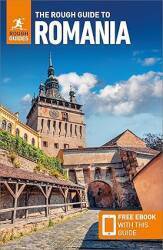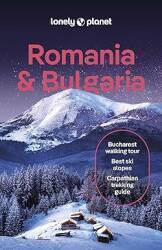
Veliko Tarnovo — Bucharest
Велико
Търново
— Bucureşti
By Train from Bulgaria to Romania
Athens to Parisby Train
The next stage of our trip was from Veliko Tarnovo, in central Bulgaria, north across the Danube River into Romania, to Bucharest. This is part of the Athens to Paris by Train series.
It was a short hop to the rail hub in Gorna Oryahovitsa, then a long ride for most of the afternoon through the rich farmland of northern Bulgaria and the farmland and oil fields of southern Romania.
Here are a pair of U.S. Government maps showing our route through Bulgaria and Romania.
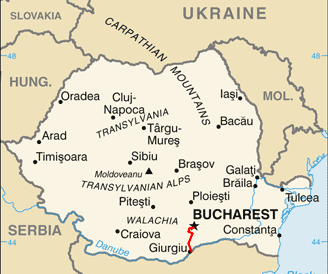
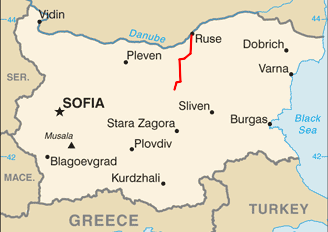
In red: Rail line from Veliko Tarnovo, Bulgaria, to Bucharest, Romania.
This U.S. military aviation map shows the complete route from Veliko Tarnovo, near the bottom, to Bucharest, near the top. Veliko Tarnovo isn't labeled on the map, but see the smokestack just south of Gorna Oryakhovitsa labeled "750 (360)", meaning that its top is 750 feet above mean sea level and 360 feet above ground level. That smokestack is in Veliko Tarnovo.
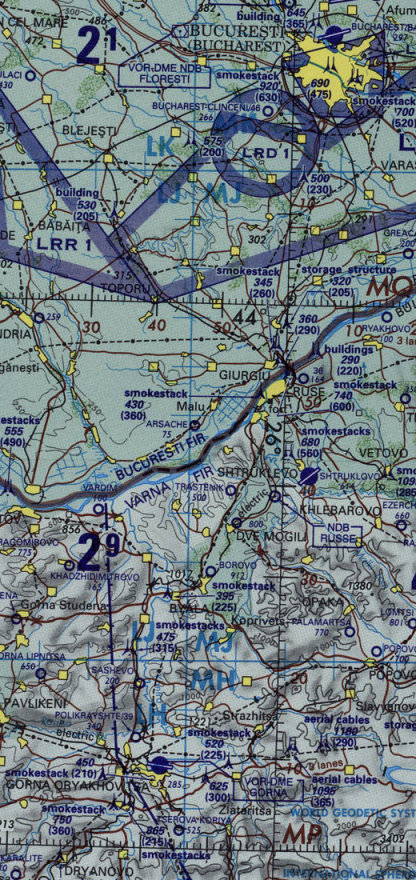
We first took a train for the short ride from Veliko Tarnovo to the Gorna Oryahovitsa station, outside the city to its northwest. We then changed trains, or really just changed cars. The second train was the result of assembling two major trains. One was running from Thessaloniki, Greece through Sofia to Bucharest, Romania. This was the continuation of the route we had taken a few days before. The other train, the one on which we had just arrived from Veliko Tarnovo, was running from İstanbul, Turkey to Bucharest.
The resulting train followed the rail line paralleling a highway running first north from Gorna Oryahovitsa and then angling northeast through a series of towns including Sashevo, Byala, Borovo, and Dve Mogili.
The Bulgarian city of Ruse is on the Danube River forming the border into Romania. We did Bulgarian exit paperwork there while the Bulgarian locomotive was replaced with a Romanian one. We moved closer to the Danube and did the Romanian entry paperwork, and then crossed the bridge into southern Romania, passing the small city of Giurgiu on the north bank of the river.
The rail line from Giurgiu to Bucharest was through mostly agricultural land spotted with oil fields.
Getting Started
We took a taxi from Hostel Mostel, where we had stayed, to the Veliko Tarnovo train station. We have purchased our tickets the day before at the Rila railway ticket agency in the center of town. Their office can be tricky to find, get good directions.
The tickets came as a pair of documents: 21.91лев for the transport and 7.33лев for the seats, or a total of just €14.95 for all three of us.
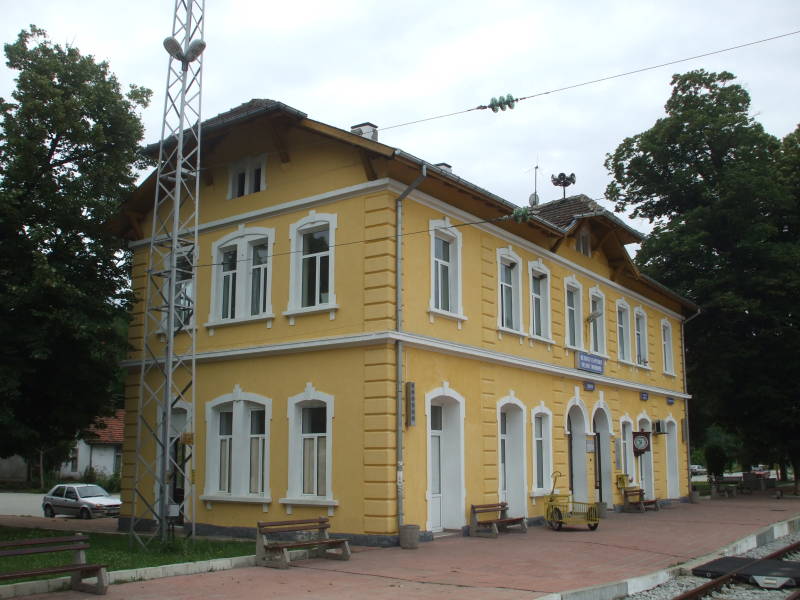
The Veliko Tarnovo train station is painted a cheery yellow. We had plenty of time to look around the station area.
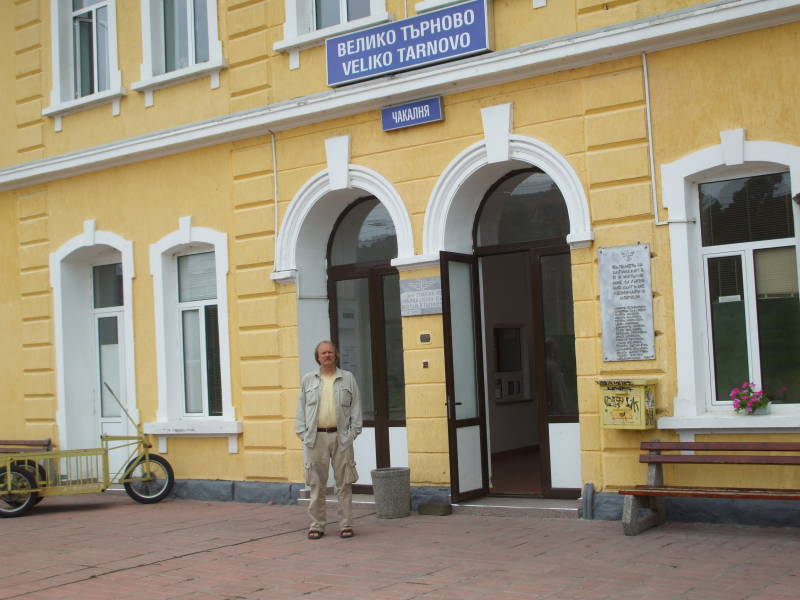
Looking down the platform, to the north, we can see how Veliko Taronvo follows a series of S-curves of the Yantra River.
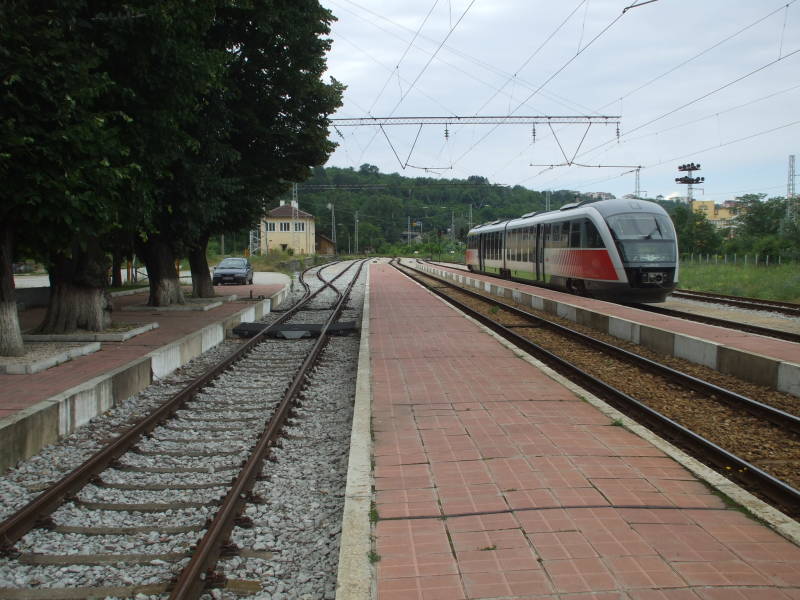
The rail line passes through one tunnel beneath part of central Veliko Tarnovo, exiting the tunnel directly onto a bridge. That bridge leads into a tunnel, which opens into another bridge.
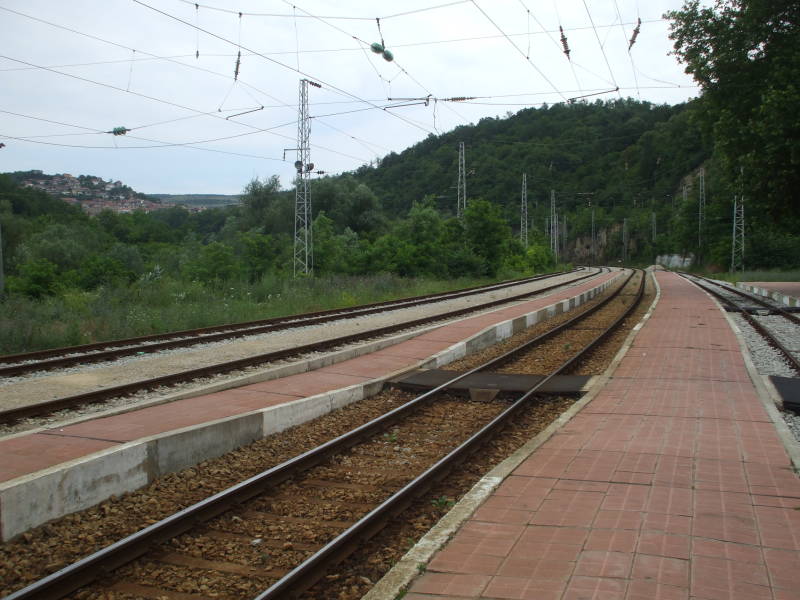
One plaque at the station commemorates the 100th anniversary of establishing a train station in Veliko Tarnovo.
The other plaque is a memorial to the seventeen listed railway workers who died while serving in the military.
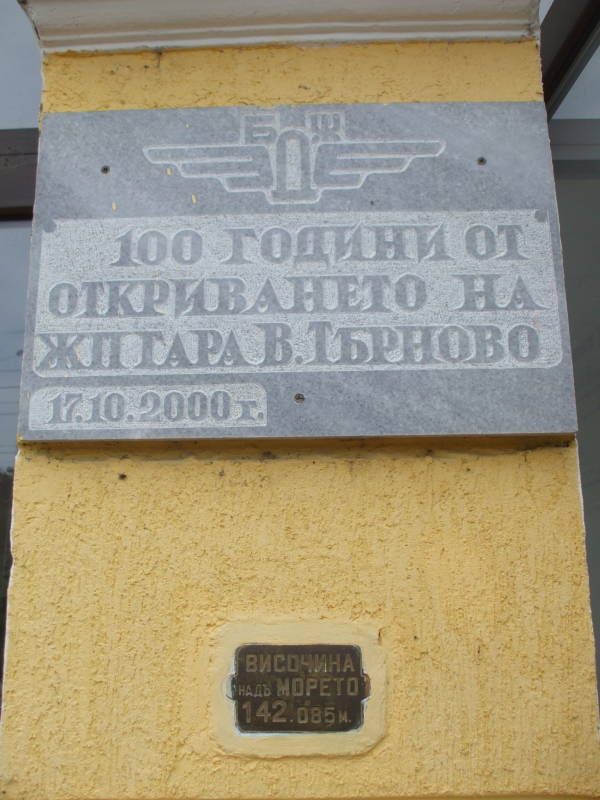
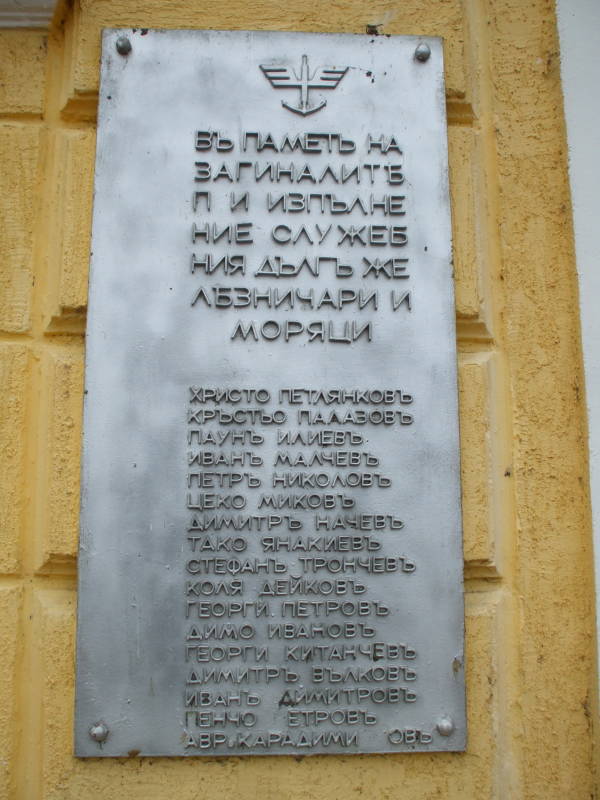
We went to the cafe across the station's parking lot to buy some drinks and some food to eat as our lunch along the way.
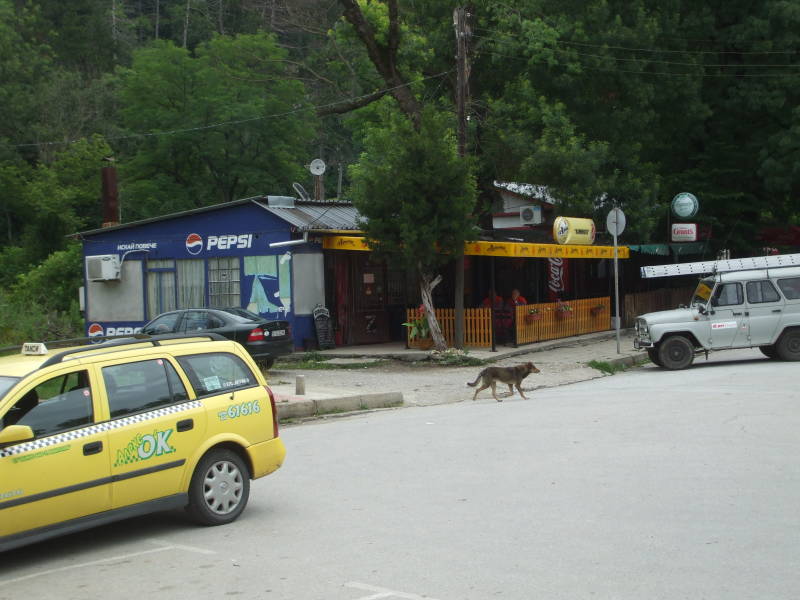
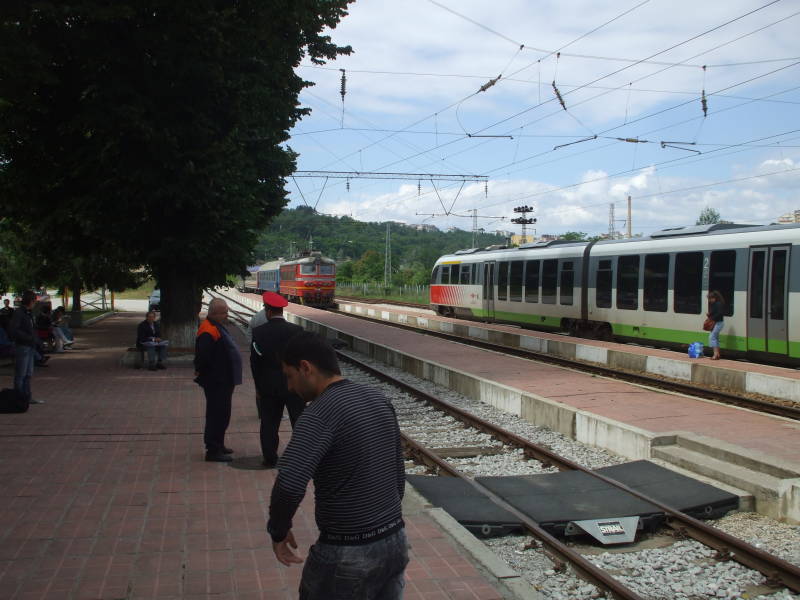
The Bosfor Ekspresi Arrives
Before long, the Bosfor Ekspresi arrives from İstanbul.
İstanbul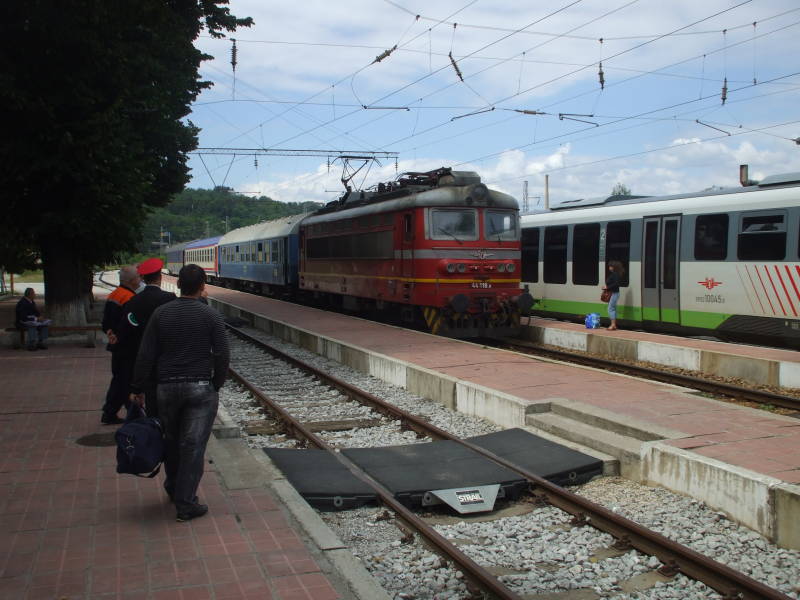
The Bosfor Ekspresi, or Bosphorus Express, arrives in Veliko Tarnovo at 11:23, having left İstanbul at 22:00 the night before. It crosses from Turkey into Bulgaria from Kapıkule to Svilengrad, running east toward Sofia. The train is split at Dimitrovgrad, some cars continuing to Sofia to arrive at 10:52 and continuing to Belgrade, and the rest turning north to pass through Stara Zagora and Veliko Tarnovo.
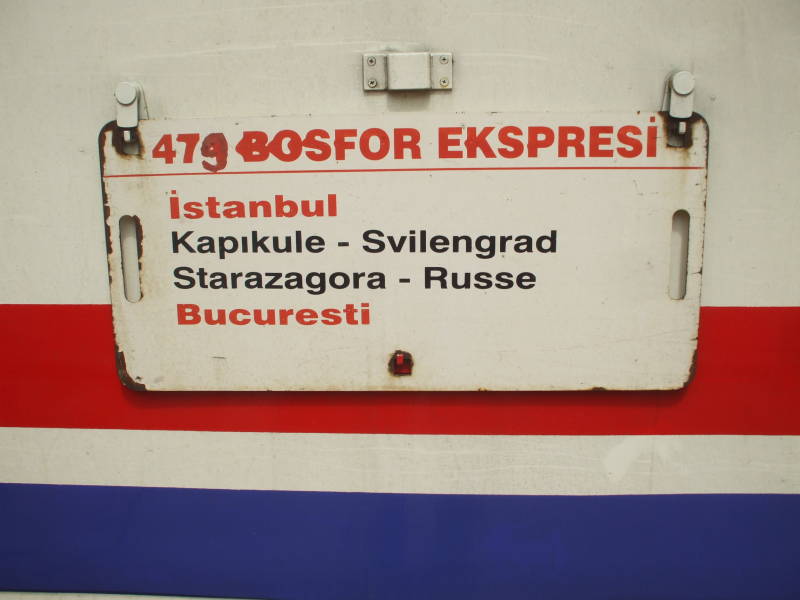
It's a short train, a blue Bulgarian coach with small compartments each with three seats facing three more seats; a white Turkish couchette car with shared compartments with three bunks on each side, and a blue Turkish sleeper car with three-bunk compartments very similar to the one we took from Thessaloniki to Sofia.
We didn't have assigned seats for this short leg, you just find somewhere to sit in the coach car for the short ride to Gorna Oryahovitsa.
The Bosfor Ekspresi pulls into Gorna Oryahovitsa a little before 12:00 if it's on schedule. Then everything shuts down as a switching locomotive is used to partially disassemble the train.
Train Disassembly and Reassembly in Gorna Oryahovitsa
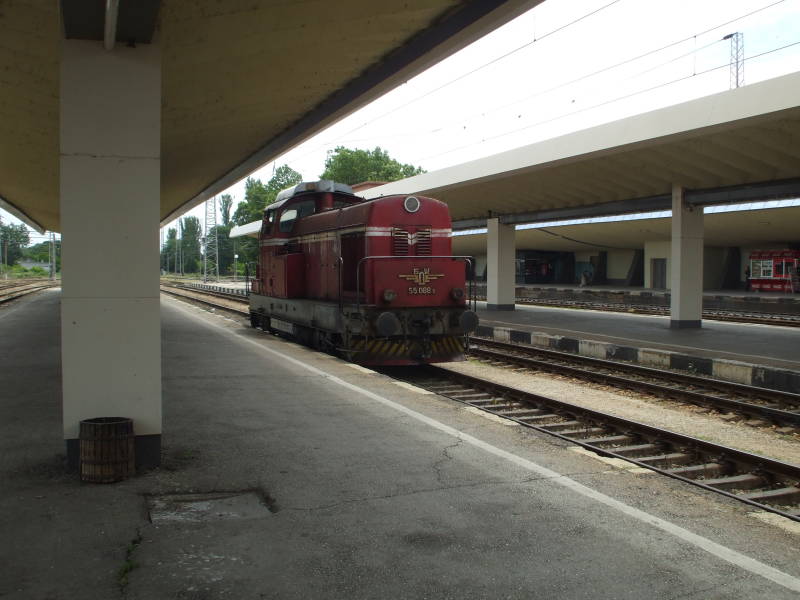
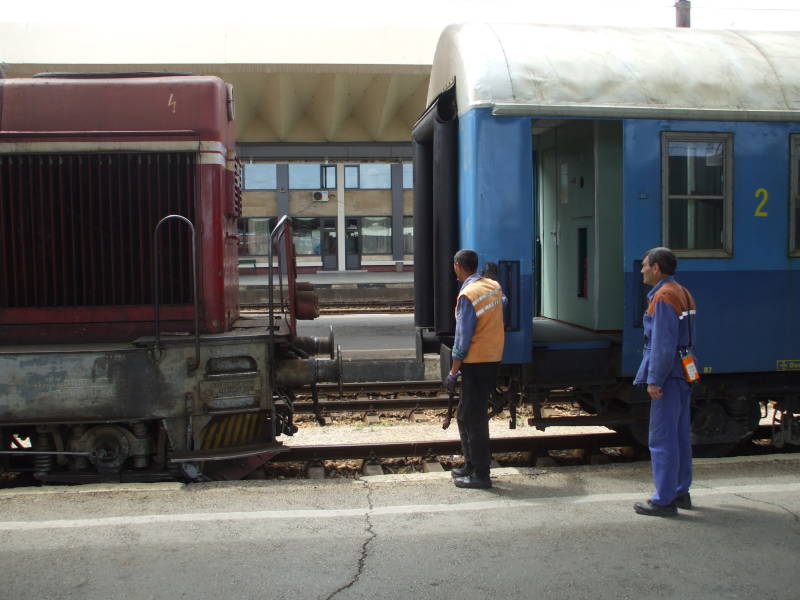
Everyone in the coach car is chased off and told to go sit in the couchette car, as this coach car doesn't continue to the north.
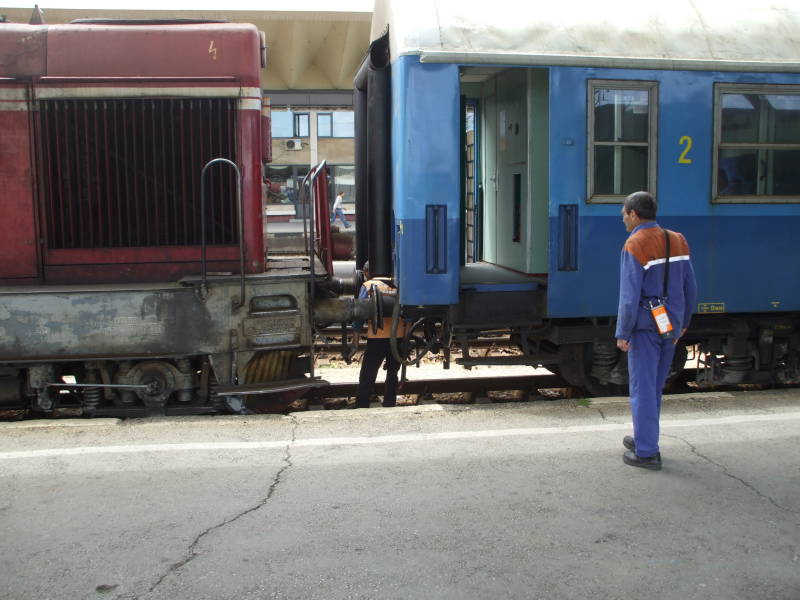
The coach car will sit in Gorna Oryahovitsa until the southbound train returning to İstanbul comes through that evening.
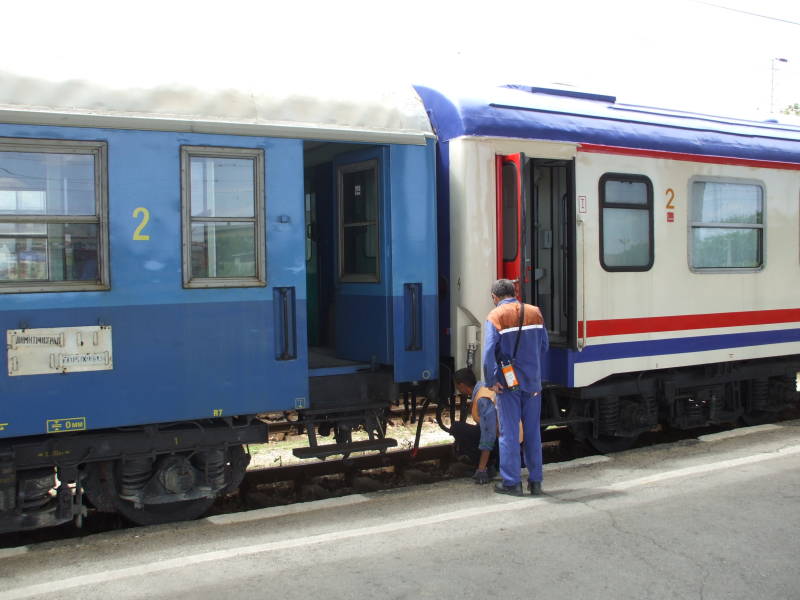
Here we see a blue Bulgarian coach car, which was attached in Dimitrovgrad, being detached from the white Turkish T.C.D.D. couchette car.
This image has been greatly reduced in size. In the original image you can read the placard: from ДИМИТРОВГРАД to Г. ОРЯХОВИЦА.
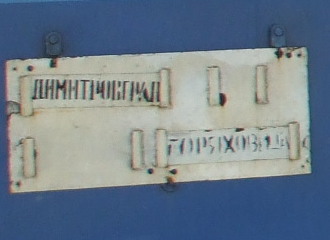
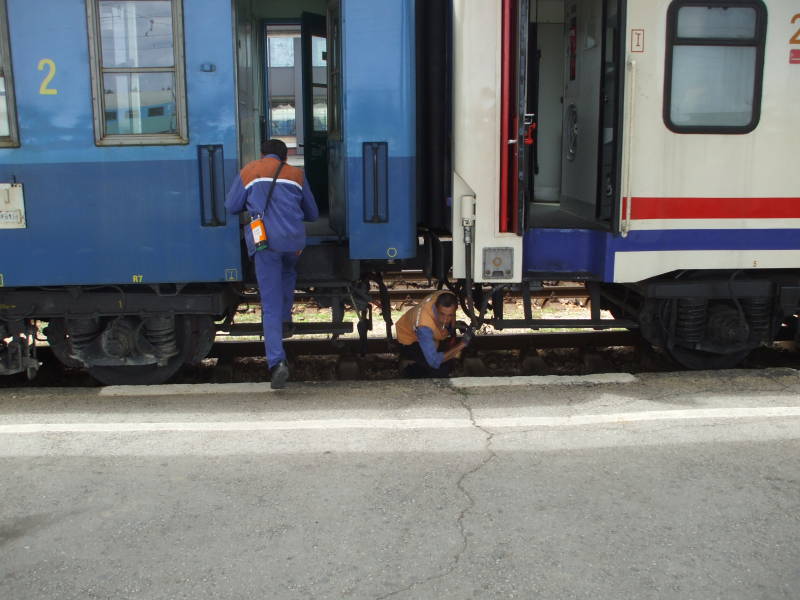
The coach car is removed to an out of the way siding.
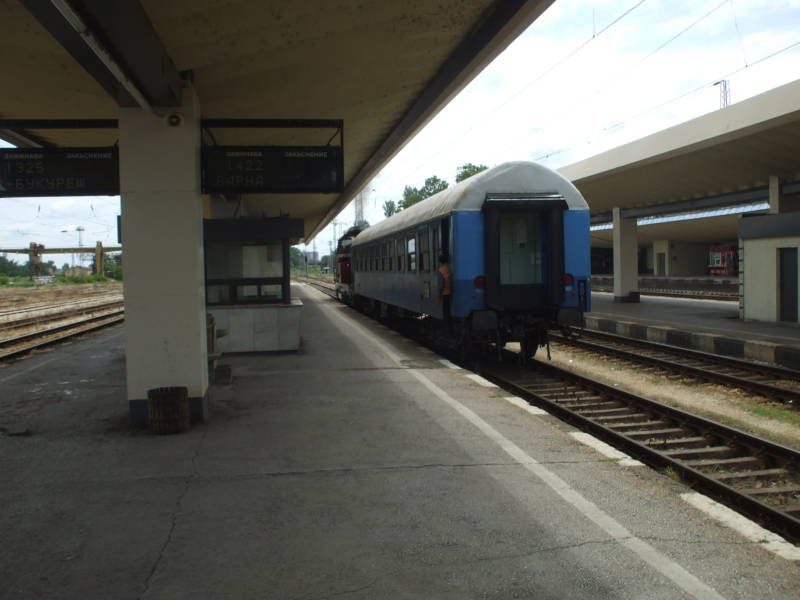
T.C.D.D. stands for Türkiye Cumhuriyeti Devlet Demiryolları, or the State Railways of the Turkish Republic.
The Quest for Baksheesh
I have ridden Turkish trains on several occasions, and have been happy with the experience. But the time spent waiting on the T.C.D.D. couchette car in Gorna Oryahovitsa was my strangest Turkish train experience ever...
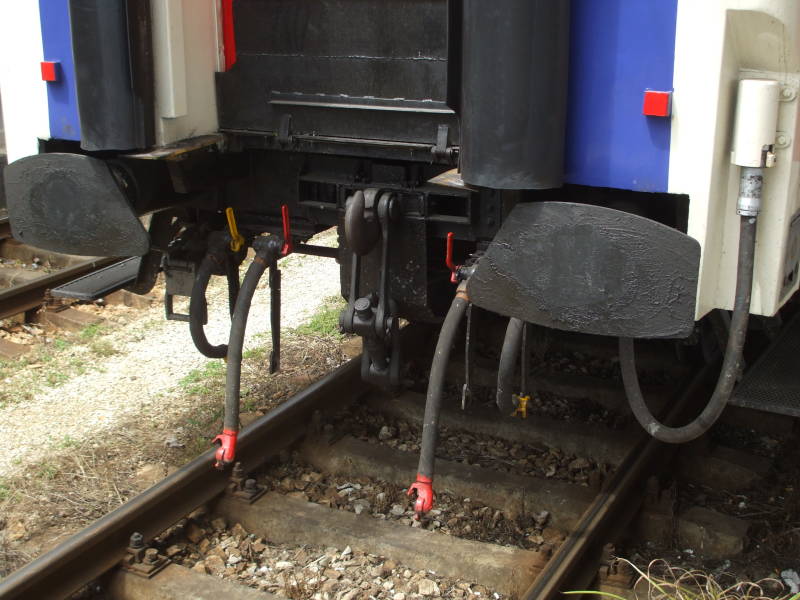
The train had arrived with a Bulgarian conductor and a Turkish couchette attendant. The Bulgarian conductor was dressed in a uniform and was all business. The Turkish attendant had no uniform, and showed up in shower flip-flops and carrying a plastic bag of fruit.
He insisted that we had to pay him ten Euros each for a couchette supplement. No, I told him, look at our tickets, we are to sit in a coach car. We already paid for our tickets, and they were less than €5 each for the entire route.
He insisted that there would be no coach car, no way to continue our trip without riding in his car and paying him this supplement. This was obviously a scam, and I told him to go away and tried to ignore him.
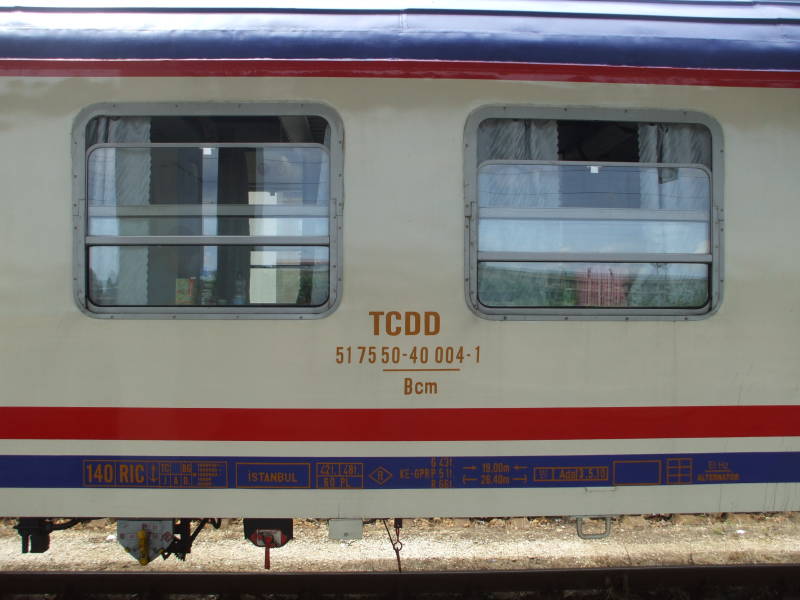
He kept pestering me about paying this supplement in a broken mix of English and Bulgarian. Knowing just a little Turkish, I asked him "Yeni vagon var mı?", or "Is there a new train car?"
Ah, it seems that I can speak Turkish! He unleashed a flurry of excited Turkish centered on that 10-Euro baksheesh he was trying for. I shrugged and told him "Türk anlamıyorum", or "I don't understand Turkish."
Then I insisted "Yeni vagon var. Bunu biliyorum." Or, "There is a new train car. I know this."
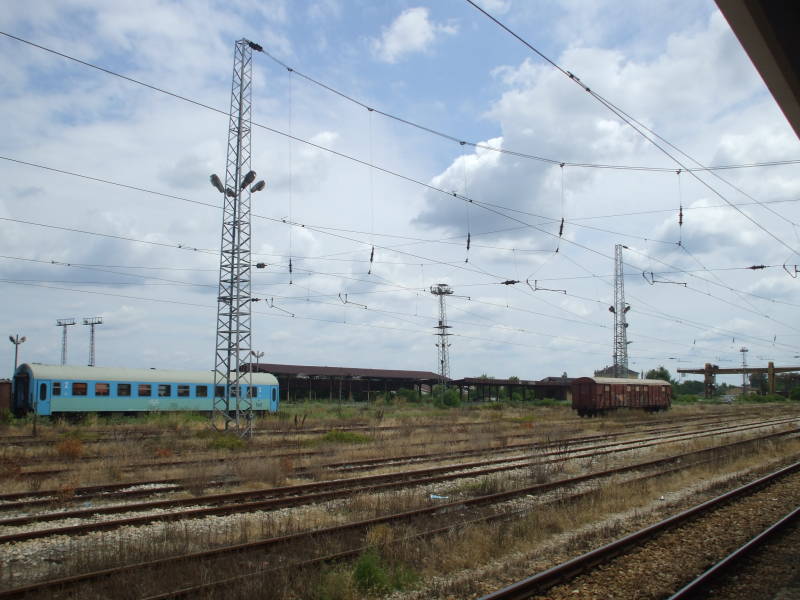
Then I asked him "Вы говорите русский язык?" Oh yes, he also spoke Russian, and he launched into something about the 10-Euro baksheesh per person that he wanted. I shrugged and told him that I spoke just a little Russian.
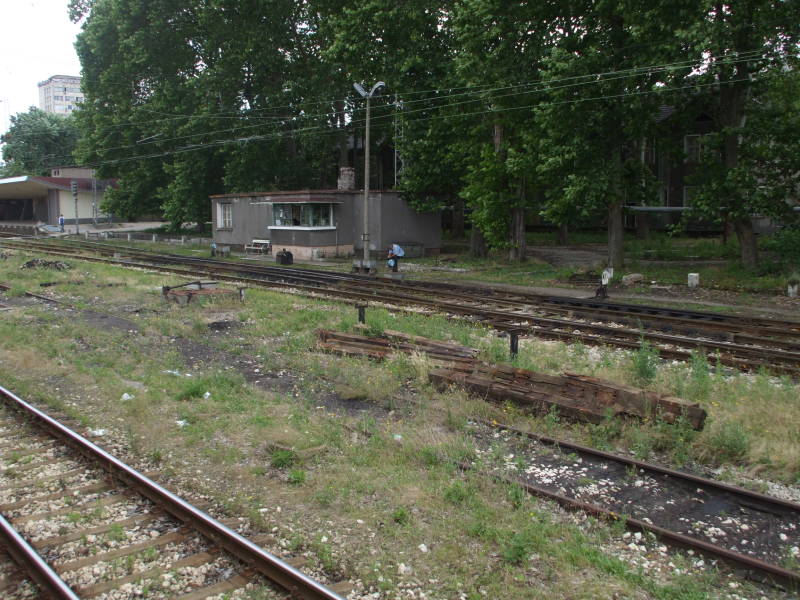
Oh, and why would we be waiting all this time if we weren't anticipating the arrival of new coach cars to be added to the train?
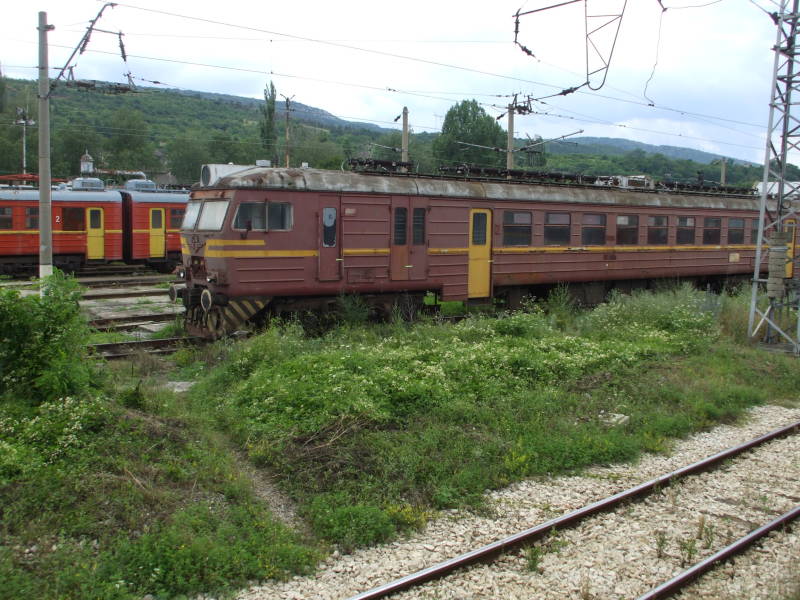
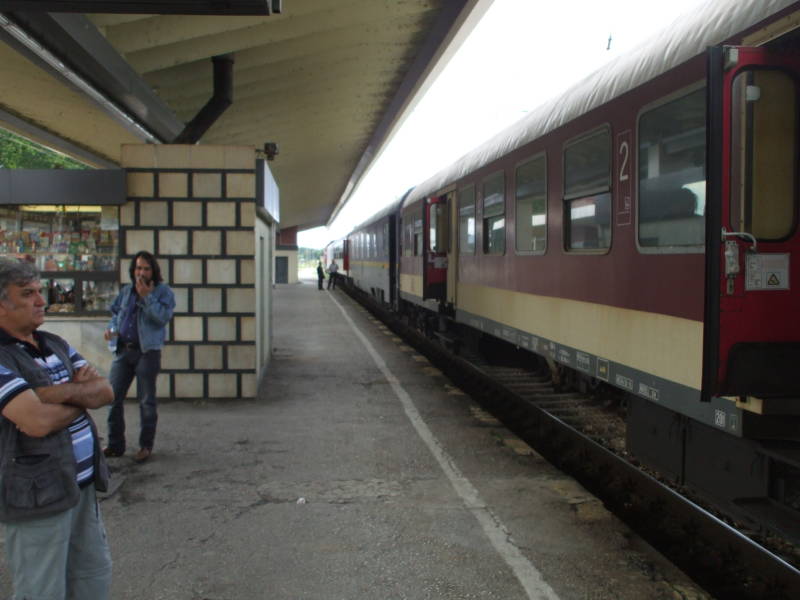
Finally, the Bulgarian coach cars arrived from Sofia. On our way to the newly attached coach cars I ran into the Turkish attendant. I told him, "Mâşallah! Yeni vagonlar var!" Or, "Praise God! The new coach cars have arrived!"
He did not appreciate this wonderful news.
North Through Bulgaria
We had our lunch once we started north from Gorna Oryahovitsa.
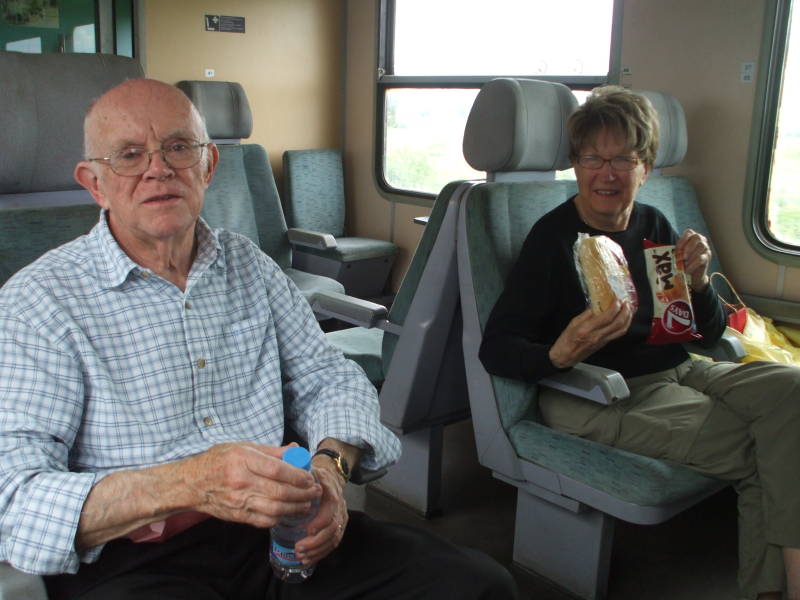
Then we watched the Bulgarian countryside roll past. The coach attached at Gorna Oryahovitsa was a single large open compartment, two seats on each side of the aisle. A few seats were grouped into facing sets of four while other rows were aligned in the same direction. This was a much nicer coach than the one we had taken from Veliko Tarnovo.
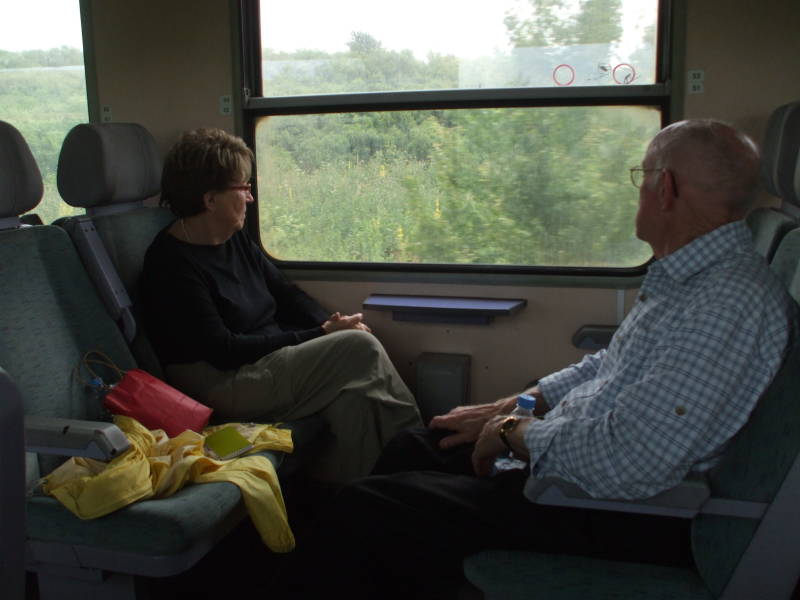

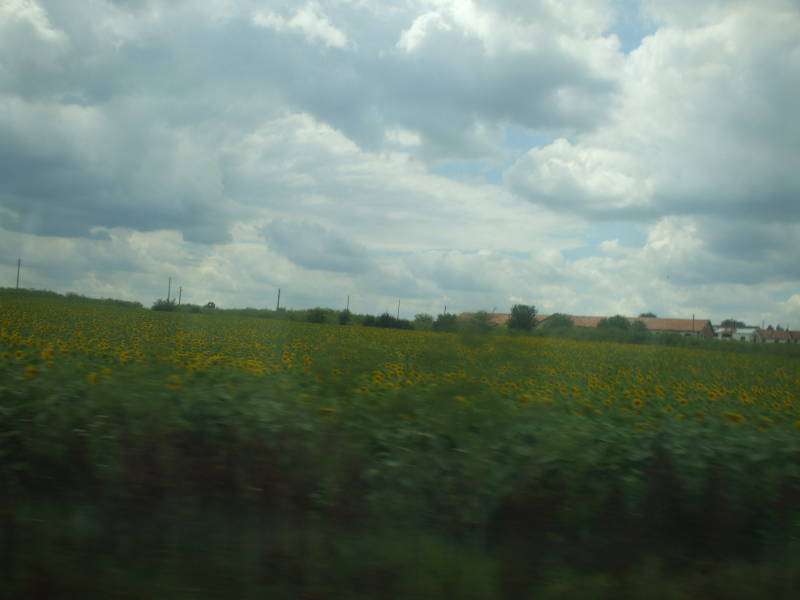
There are large fields of nothing but sunflowers.
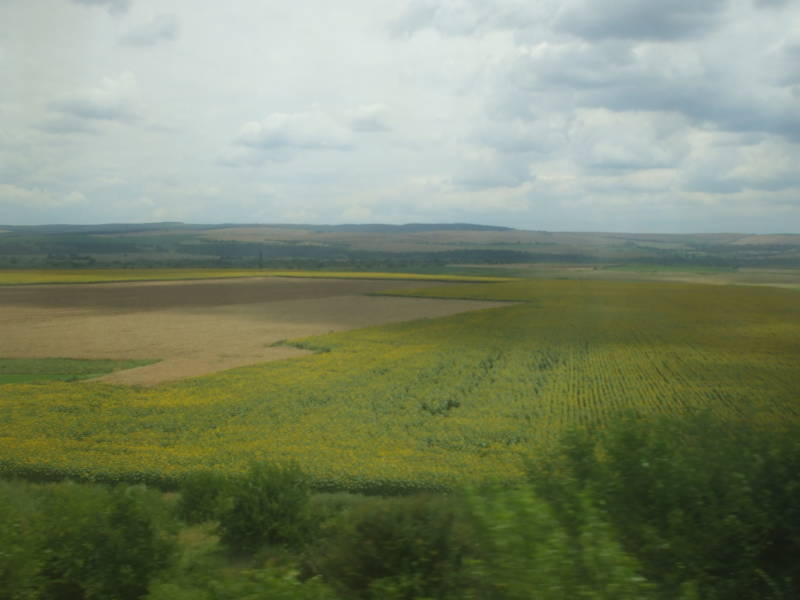
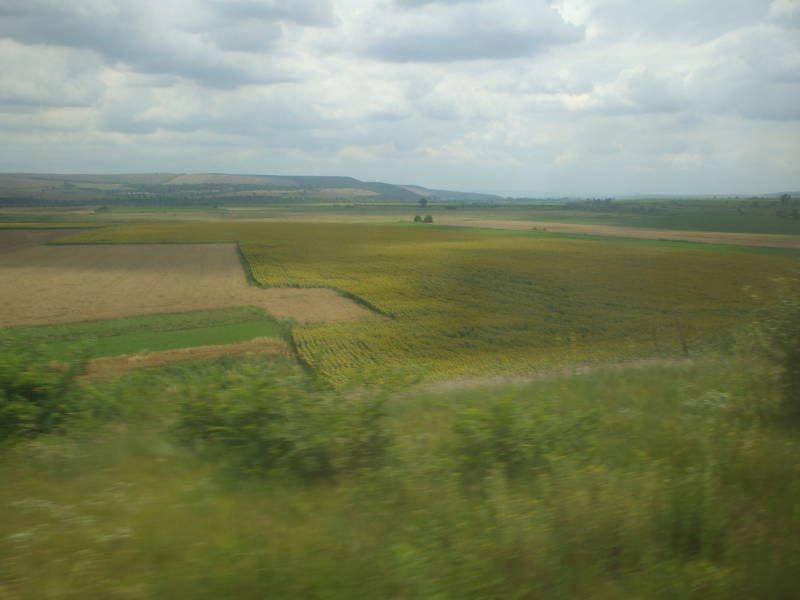
Every so often we passed some large grain elevators. The open plains of northern Bulgaria nearing the Danube River contain some very productive farmland.
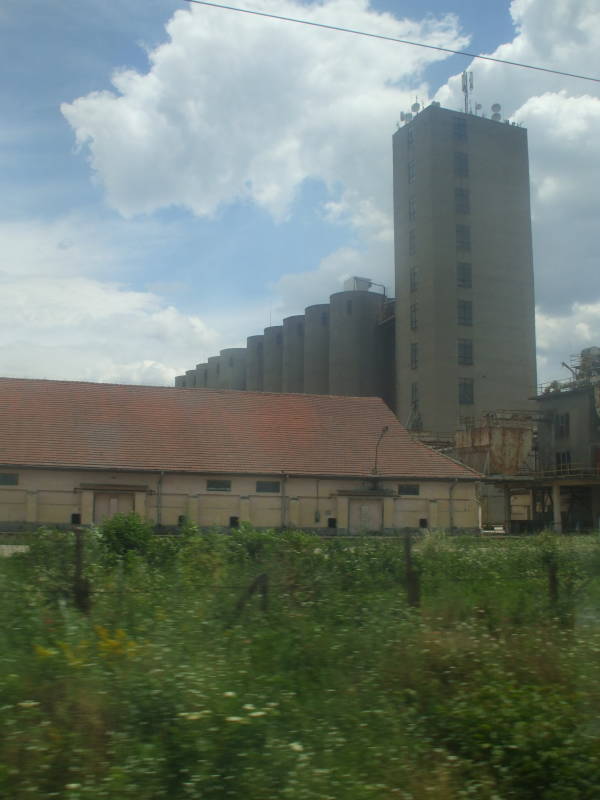
Somehow these Bulgarians manage to run very productive agricultural operations without gigantic pickup trucks. They also do not seem to wear cowboy hats or enormous belt buckles or other pieces of cowboy costumes. And, as far as I could tell, they were willing to speak correct Bulgarian without mangling their grammar and pronunciation.
So it seems that Bulgarian agriculture is rather different from the American variety.
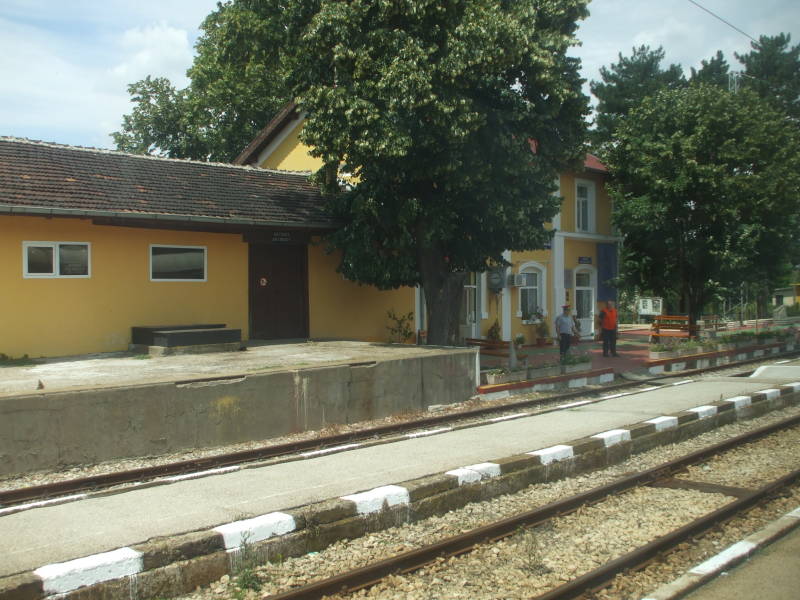
We stopped briefly in Две-Могили as we made our way north.
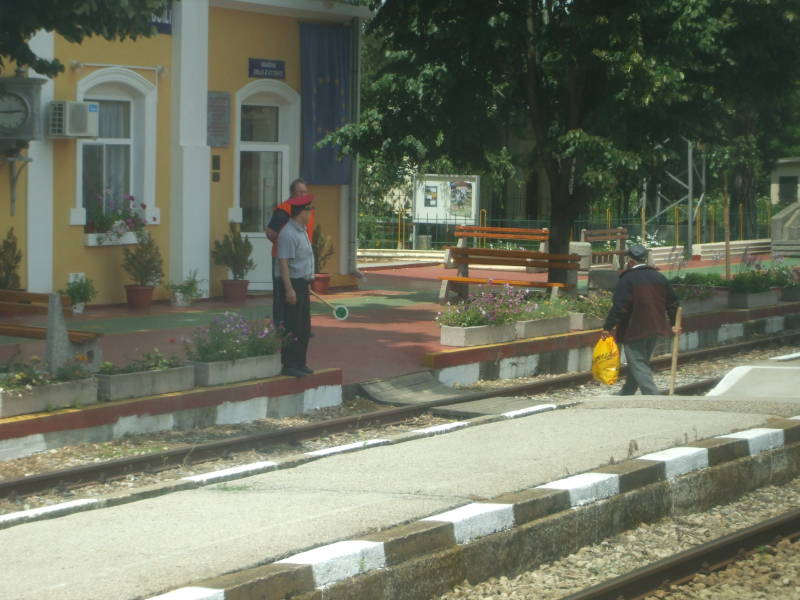
We are getting close enough to the Romanian border to start seeing dual-language signs.
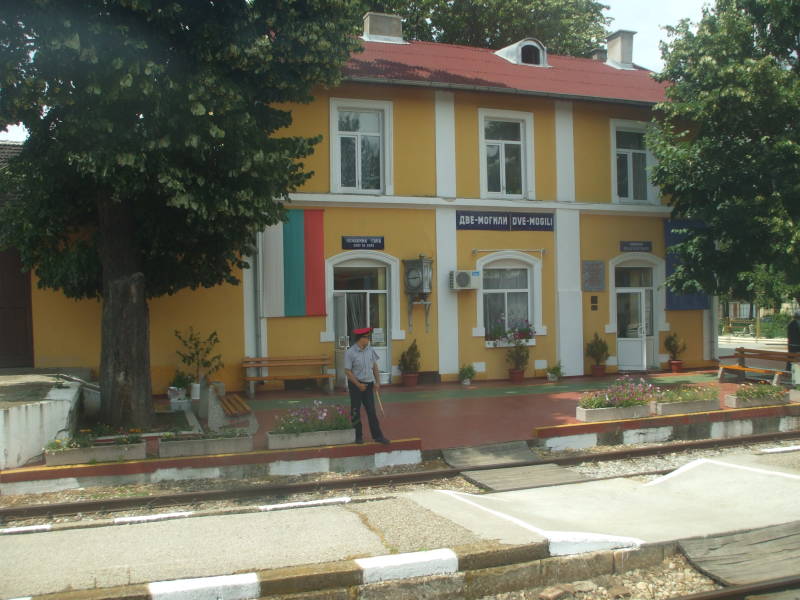
The station name itself appears in both Cyrillic and Latin script, Две-Могили and Dve-Mogili. We saw that back in Veliko Tarnovo.



The door at the left is also labeled in both Bulgarian and Romanian, Началник Гара and Chef de Gare, and the door at right is labeled as both Чакалня and Salle d'Attente.
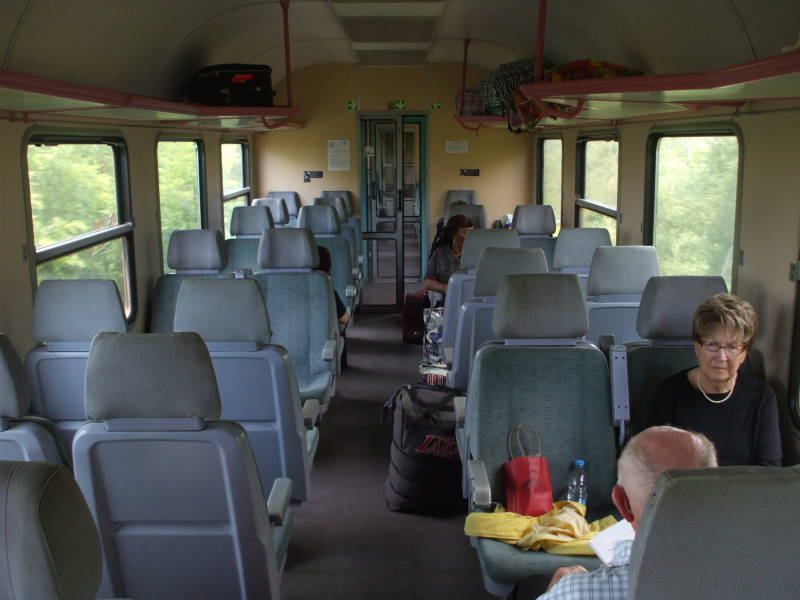
There were were just a few other people in our car.
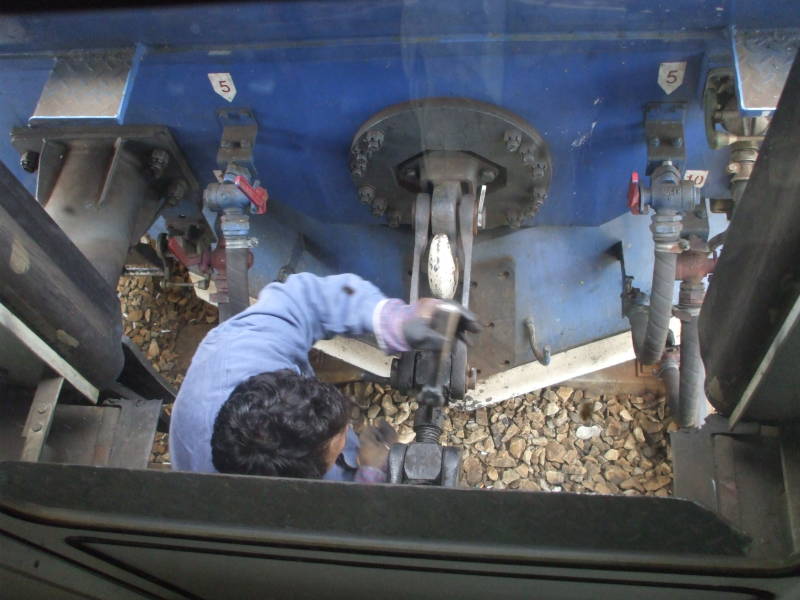
Crossing the Danube
The Bulgarian locomotive was disconnected as we reached the outskirts of Русе, or Ruse (sometimes transliterated Rousse), on the Danube River and the Romanian border. A Romanian locomotive was connected to pull the train the rest of the way to Bucharest.
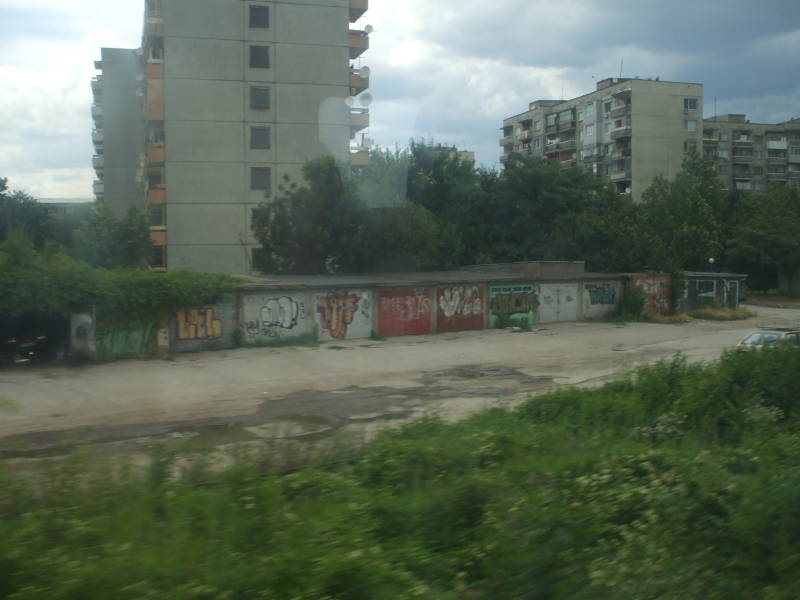
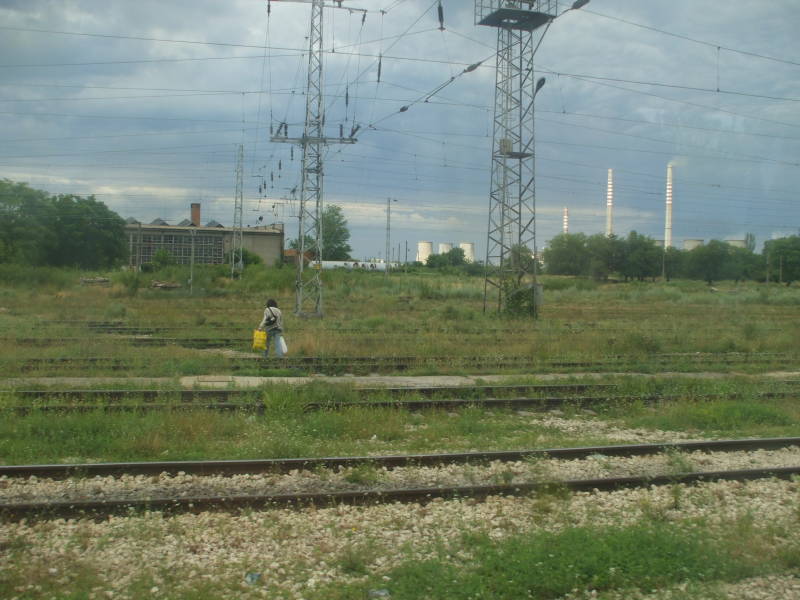
That's the 400 MW Ruse Iztok Power Plant in the distance, and a Bulgarian electrically powered locomotive waiting to be attached to a train.
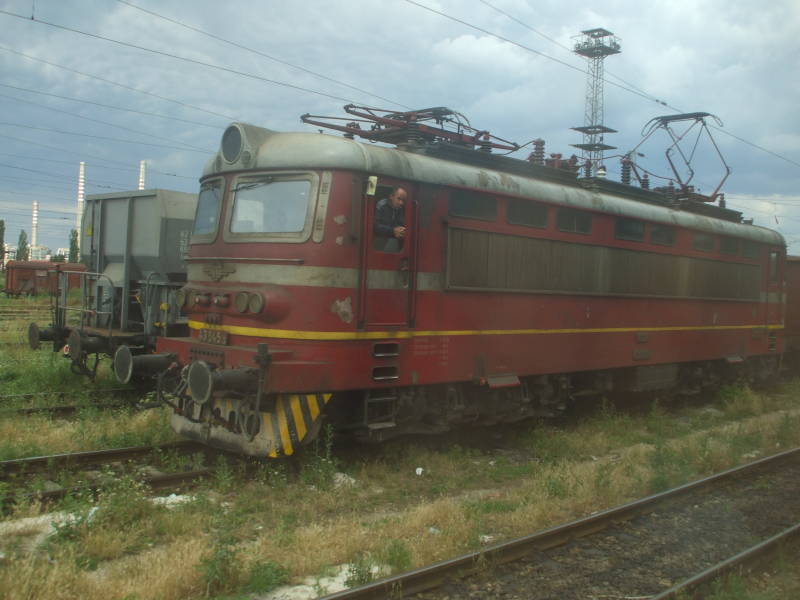
Лукойл, or Lukoil, is a Russian oil company. We were nearing the oil fields of southern Romania.
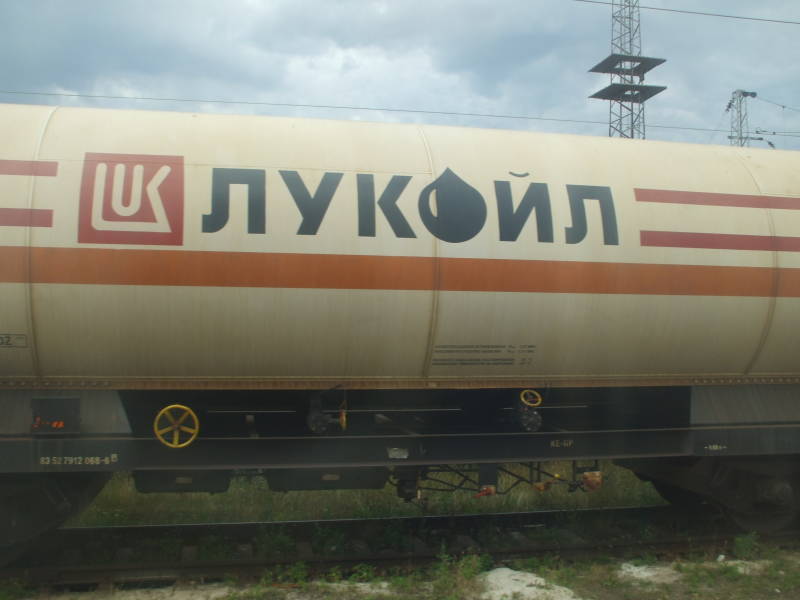
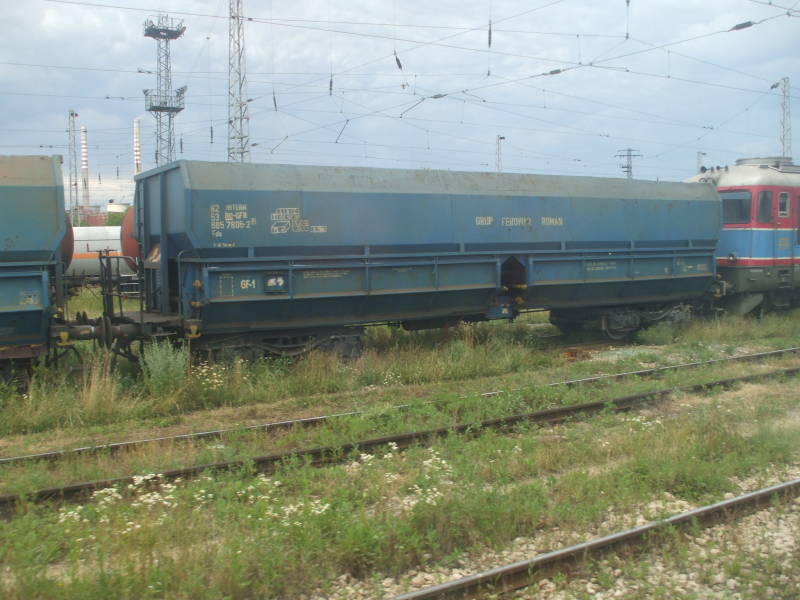
The red and blue Grup Feroviar Român locomotive belongs to the largest private railway company in Romania.
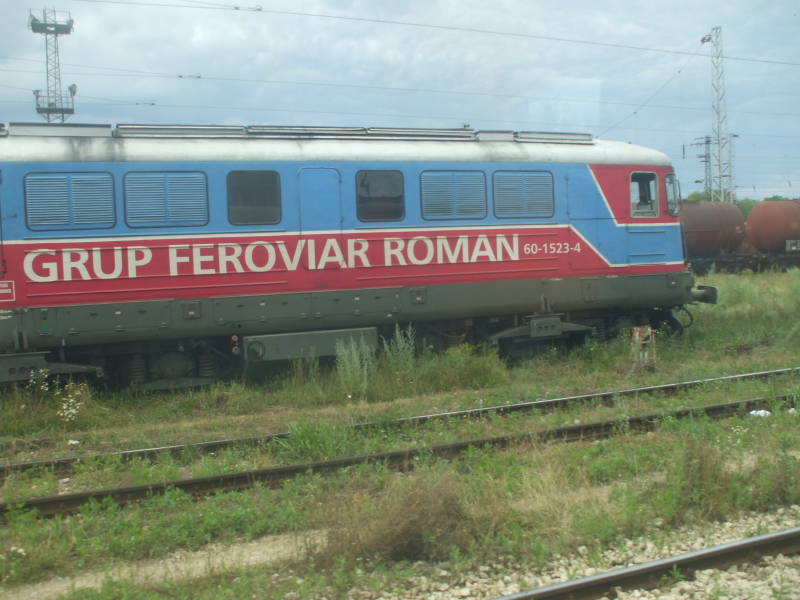
We stopped near the border and had our passports checked and stamped by first Bulgarian and then Romanian border guards.

Soon after we started again, we saw the piers of Ruse and the Danube River. Or, the Дунав or Dunav as the Bulgarians call it.
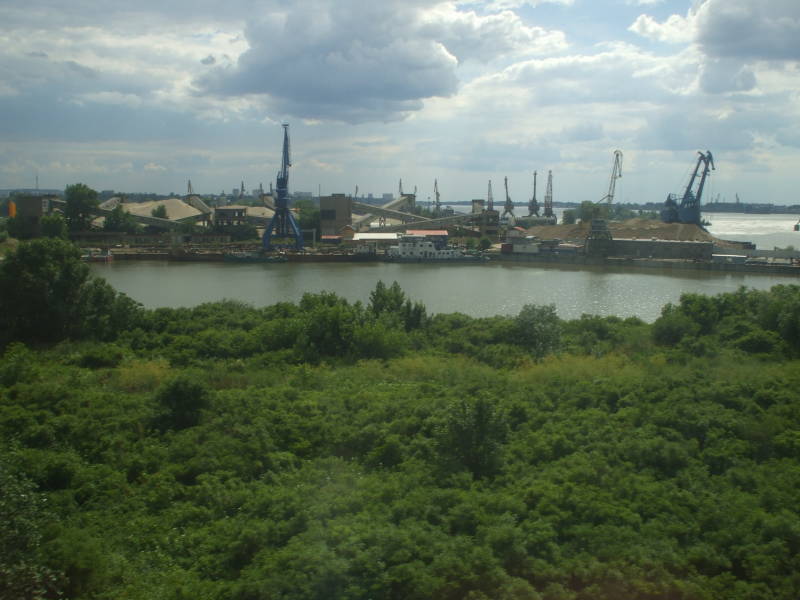
Ruse is a major industrial center. There is machinery and ship construction, with the Ruse shipyard and Vripack, a yacht design company. Also, light industries (textiles and food processing), petroleum and chemical plants, and large metal-working companies.
The Danube is quite wide. In the first picture below, we are looking west or upstream as we begin to cross the bridge. It is a large river, starting in the Black Forest in southwestern Germany and draining most of central and eastern Europe south of the Czech Republic and Poland. The Volga is the only European river that is longer, and it's all the way east in central Russia, draining into the Caspian Sea.
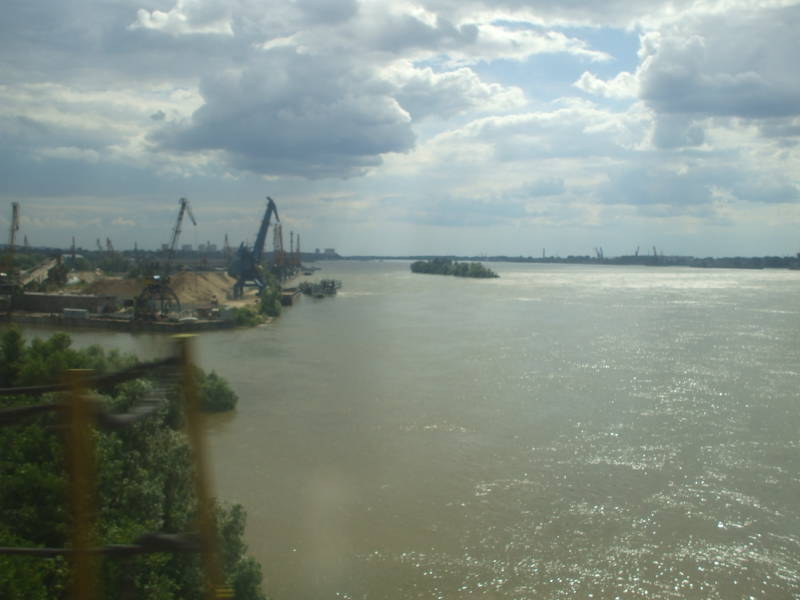
In the second picture we are looking downstream from the Danube Bridge as we cross from Bulgaria to the Romanian city of Giurgiu.
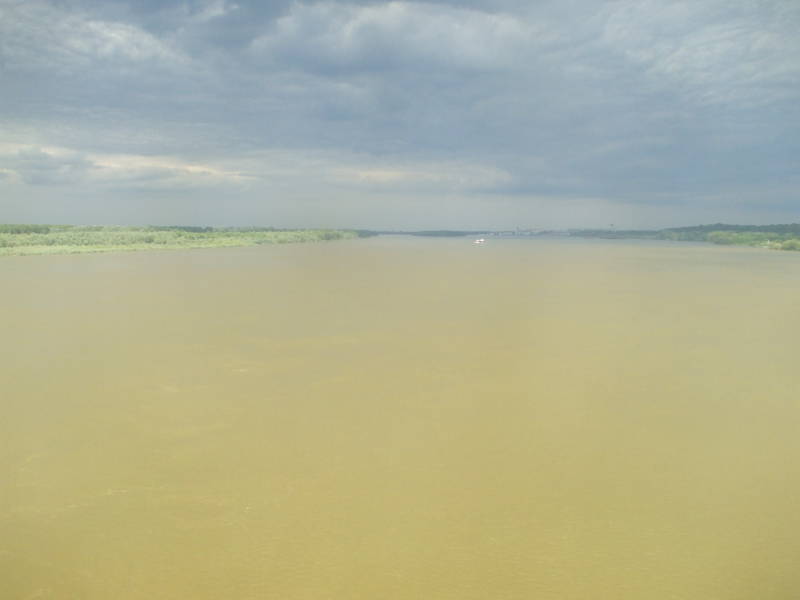
It's a large bridge, 2,223 meters (7,293') long with a clearance below of 30 meters (98') to accommodate large ships bound downstream to the Black Sea. Plus, an 85 meter center span can be lifted higher if needed. There are two highway lanes above and two rail lines below.
The bridge was built with the aid of the Soviet Union, which opened it in 1954 under the name of the "Friendship Bridge". With the fall of communism and everyone's distaste for the Soviet era politicized labels, it has come to be known simply as the Danube Bridge.
Through the Romanian Oil Fields
The Romanian farmland looked just as productive as that south of the river in Bulgaria.
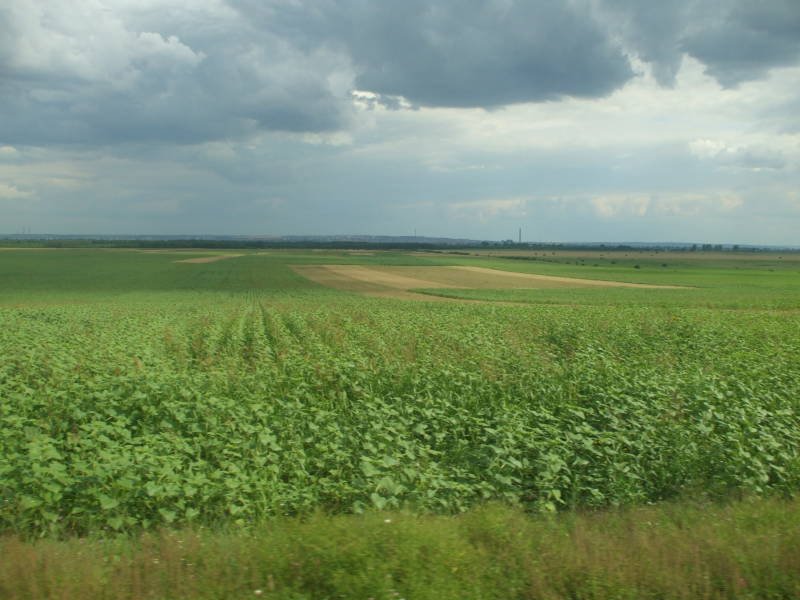
We soon started seeing oil wells. Romania was once Europe's largest oil producer, including during World War II when its oil was essential for the German military.

Amazon
ASIN: B00492CFWQ
Amazon
ASIN: 1455622184
Much of the resources were squandered during Ceauşescu's regime, and Romania is now a net importer of oil. In 2004 they produced 5,465,000 metric tons of crude petroleum. The country retains substantial oil refining capacity, the largest in the region with ten major refineries able to process about 500,000 barrels per day. Romania exports a wide range of petrochemicals throughout the region.
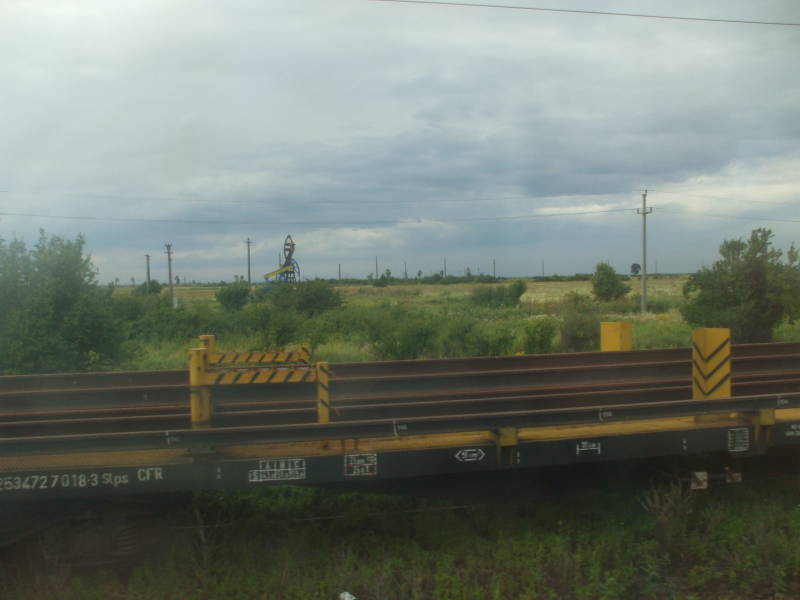
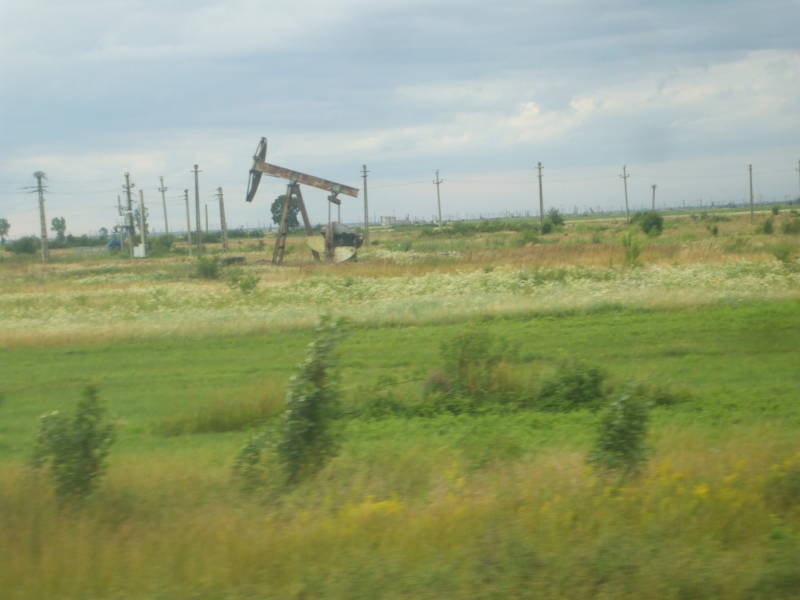
Arrival in Bucharest
We arrived at Bucureşti Gară de Nord, Bucharest's main passenger train station. The Romanian "Gară de Nord" is very similar to the equivalent French "Gare de Nord" as the two languages are related Romance or Latin-based languages.
Bucureşti Gară de Nord is a large station with 14 tracks and 8 platforms handling about 200 trains a day. In addition to Turkey and Bulgaria, the source of the train we arrived on, there are also international connections to Budapest, Hungary; Vienna, Austria; Chişinău, Moldova; Kiev, Ukraine; Belgrade, Serbia; and Moscow, Russia.
The state railway carrier is Căili Ferate Român. Romania has a railway network of 11,380 km, with 3,971 km electrified. The newer diesel locomotives, like the ones seen here, have mostly been painted in a blue scheme. Post-1999 electric locomotives are red. The older locomotives of both power types are grey.
Amazon
ASIN: 0995799830
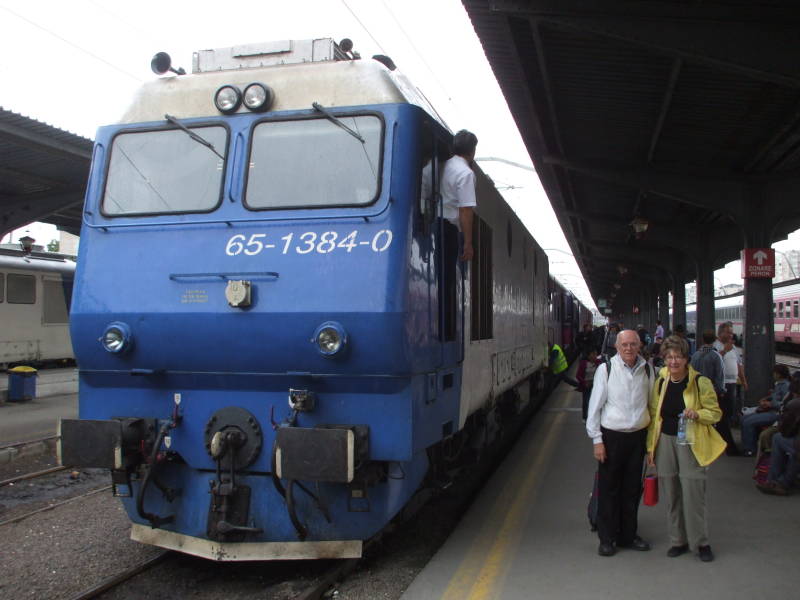
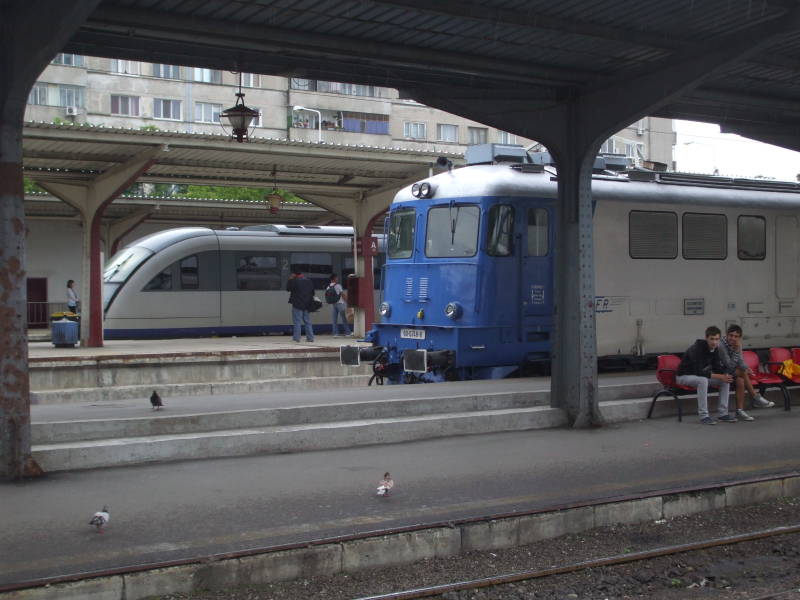
We stayed at the Hotel Elizeu,
just a short walk from the station and €45
for a double room:
11-13 Elizeu Str
+40-21-319-17-34, +40-21-319-17-35
hotelelizeu.ro
